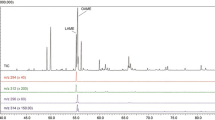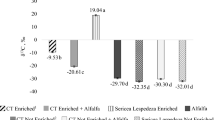Abstract
In an effort to understand the relationships between both the lipid content and δ13C values of Collembola and their diet, isotopically labelled (C3 and C4) bakers’ yeasts were cultured and fed to two Collembolan species, Folsomia candida and Proisotoma minuta. The fatty acid composition of Collembola generally reflected that of the diet with the addition of the polyunsaturated components 18:2(n-6), 20:4(n-6) and 20:5(n-3), which appeared to be biosynthesised by the Collembola. Whilst ergosterol was the only sterol detected in the yeast diets, only cholesterol was detected in Collembola, and although the δ13C values of diet and consumer sterols differed by >2‰, the δ13C values indicated that cholesterol was derived entirely from dietary sterol. The bulk δ13C values of Collembola were similar to those of the diets, but fatty acid δ13C values did not necessarily reflect those of the dietary fatty acids, indicating significant de novo biosynthesis of fatty acids within Collembola. Switching the Collembola from C3 to C4 yeast enabled the determination of the rates of incorporation of dietary carbon into Collembolan lipids, and showed that half-lives of the incorporation of dietary carbon varied between 1.5 and 5.8 days at 20°C. Cholesterol exhibited the slowest rate of incorporation in both species, while bulk carbon in F. candida possessed an intermediate rate. These results demonstrate that an understanding of the sources of isotopic fractionation and the role of biochemistry in regulating the δ13C values of individual compounds is important in the application of compound-specific isotopic analysis to the study of animal trophic activities.




Similar content being viewed by others
References
Behmer ST, Grebenok RJ (1998) Impact of dietary sterols on life-history traits of a caterpillar. Physiol Entomol 23:165–175
Boutton TW, Smith BN, Harrison AT (1980) Carbon isotope ratios and crop analyses of Arphia (Orthoptera: Acrididae) species in southeastern Wyoming grassland. Oecologia 45:299–306
Briones MJI, Ineson P, Sleep D (1999) Use of δ13C to determine food selection in collembolan species. Soil Biol Biochem 31:937–940
Craig H, Chou CC, Welhan JA, Stevens CM, Engelkemeir A (1988) The isotopic composition of methane in Polar ice cores. Science 242:1535–1539
Cripps GC, Atkinson A (2000) Fatty acid composition as an indicator of carnivory in Antarctic krill, Euphausia superba. Can J Fish Aquat Sci 57:31–37
DeNiro MJ, Epstein S (1977) Mechanism of carbon isotope fractionation associated with lipid synthesis. Science 197:261–263
DeNiro MJ, Epstein S (1978) Influence of diet on the distribution of carbon isotopes in animals. Geochim Cosmochim Acta 42:495–506
Downer RGH (1985) Lipid metabolism. In: Kerkut GA, Gilbert LI (eds) Comprehensive insect physiology, biochemistry and pharmacology, vol 10. Pergamon, Oxford, pp 77–113
Ehleringer JR (1991) 13C/12C fractionation and its utility in terrestrial plant studies. In: Coleman DC, Fry B (eds) Carbon isotope techniques. Academic Press, San Diego, pp 187–200
Fantle MS, Dittel AI, Schwalm SM, Epifanio CE, Fogel ML (1999) A food web analysis of the juvenile blue crab, Callinectes sapidus , using stable isotopes in whole animals and individual amino acids. Oecologia 120:416–426
Fernando-Warnakulasuriya GJP, Tsuchida K, Wells MA (1988) Effect of dietary lipid content on lipid transport and storage during larval development of Manduca sexta. Insect Biochem 18:211–214
Gannes LZ, del Rio CM, Koch P (1998) Natural abundance variations in stable isotopes and their potential uses in animal physiological ecology. Comp Biochem Physiol A 119:725–737
Ghioni C, Bell JG, Sargent JR (1996) Polyunsaturated fatty acids in neutral lipids and phospholipids of some freshwater insects. Comp Biochem Physiol B 114:161–170
Graeve M, Kattner G, Hagen W (1994) Diet induced changes in the fatty acid composition of Arctic herbivorous copepods—experimental evidence of trophic markers. J Exp Mar Biol Ecol 182:97–110
Graeve M, Dauby P, Scailteur Y (2001) Combined lipid, fatty acid and digestive tract content analyses: a penetrating approach to estimate feeding modes of Antarctic amphipods. Polar Biol 24:853–862
Grice K, Breteler W, Schouten S, Grossi V, de Leeuw JW, Damste JSS (1998) Effects of zooplankton herbivory on biomarker proxy records. Paleoceanography 13:686–693
Hanson BJ, Cummins KW, Cargill AS, Lowry RR (1985) Lipid content, fatty acid composition, and the effect of diet on fats of aquatic insects. Comp Biochem Physiol B 80:257–276
Hayes JM (1993) Factors controlling 13C contents of sedimentary organic compounds—principles and evidence. Mar Geol 113:111–125
Hobson KA, Clark RG (1992a) Assessing avian diets using stable isotopes. 1. Turnover of 13C in tissues. Condor 94:181–188
Hobson KA, Clark RG (1992b) Assessing avian diets using stable isotopes. 2. Factors influencing diet-tissue fractionation. Condor 94:189–197
Holmstrup M, Hedlund K, Boriss H (2002) Drought acclimation and lipid composition in Folsomia candida: implications for cold shock, heat shock and acute desiccation stress. J Insect Physiol 48:961–970
Hopkin SP (1997) Biology of the springtails (Insecta: Collembola). Oxford University Press, Oxford
Joanisse DR, Storey KB (1996) Fatty acid content and enzymes of fatty acid metabolism in overwintering cold-hardy gall insects. Physiol Zool 69:1079–1095
Jones TH, et al (1998) Impacts of rising atmospheric carbon dioxide on model terrestrial ecosystems. Science 280:441–443
Joosse ENG, Testerink GJ (1977) The role of food in the population dynamics of Orchesella cincta (Linné) (Collembola). Oecologia 29:189–204
Kanazawa A (2001) Sterols in marine invertebrates. Fish Sci 67:997–1007
Klironomos JN, Kendrick WB (1996) Palatability of microfungi to soil arthropods in relation to the functioning of arbuscular mycorrhizae. Biol Fertil Soils 21:43–52
Magnusson WE, et al (1999) Contributions of C3 and C4 plants to higher trophic levels in an Amazonian savanna. Oecologia 119:91–96
McNabb DM, Halaj J, Wise DH (2001) Inferring trophic positions of generalist predators and their linkage to the detrital food web in agroecosystems: a stable isotope analysis. Pedobiologia 45:289–297
Meier-Augenstein W (1999) Applied gas chromatography coupled to isotope ratio mass spectrometry. J Chromatogr A 842:351–371
Meier-Augenstein W (2002) Stable isotope analysis of fatty acids by gas chromatography- isotope ratio mass spectrometry. Anal Chim Acta 465:63–79
Monson KD, Hayes JM (1982) Carbon isotopic fractionation in the biosynthesis of bacterial fatty acids—ozonolysis of unsaturated fatty acids as a means of determining the intramolecular distribution of carbon isotopes. Geochim Cosmochim Acta 46:139–149
Nardi F, Spinsanti G, Boore JL, Carapelli A, Dallai R, Frati F (2003) Hexapod origins: monophyletic or paraphyletic? Science 299:1887–1889
Neilson R, et al (1998) Stable isotope natural abundances of soil, plants and soil invertebrates in an upland pasture. Soil Biol Biochem 30:1773–1782
Neven LG (2000) Physiological responses of insects to heat. Postharvest Biol Technol 21:103–111
O’Brien DM, Fogel ML, Boggs CL (2002) Renewable and nonrenewable resources: amino acid turnover and allocation to reproduction in Lepidoptera. Proc Natl Acad Sci USA 99:4413–4418
Oelbermann K, Scheu S (2002) Stable isotope enrichment (δ15N and δ13C) in a generalist predator ( Pardosa lugubris, Araneae: Lycosidae): effects of prey quality. Oecologia 130:337–344
Ogg CL, Stanley-Samuelson DW (1992) Phospholipid and triacylglycerol fatty acid compositions of the major life stages and selected tissues of the tobacco hornworm Manduca sexta. Comp Biochem Physiol B 101:345–351
Ostrom PH, Colunga Garcia M, Gage SH (1997) Establishing pathways of energy flow for insect predators using stable isotope ratios: field and laboratory evidence. Oecologia 109:108–113
Petelle M, Haines B, Haines E (1979) Insect food preferences analysed using 13C/12C ratios. Oecologia 38:159–166
Ponsard S, Arditi R (2000) What can stable isotopes (δ15N and δ13C) tell about the food web of soil macro-invertebrates? Ecology 81:852–864
Rieley G (1994) Derivatization of organic compounds prior to gas-chromatographic combustion-isotope ratio mass-spectrometric analysis—identification of isotope fractionation processes. Analyst 119:915–919
Rossmann A, Butzenlechner M, Schmidt HL (1991) Evidence for a nonstatistical carbon isotope distribution in natural glucose. Plant Physiol 96:609–614
Sayah F, Karlinsky A, Breuzet M (1997) Lipid and fatty acid composition of the fat body during the female reproductive cycle of Labidura riparia (Insecta: Dermaptera). J Comp Physiol B Biochem Syst Environ Physiol 167:502–507
Schmidt O, Scrimgeour CM, Handley LL (1997) Natural abundance of 15N and 13C in earthworms from a wheat and a wheat-clover field. Soil Biol Biochem 29:1301–1308
Schmidt O, Scrimgeour CM, Curry JP (1999) Carbon and nitrogen stable isotope ratios in body tissue and mucus of feeding and fasting earthworms ( Lumbricus festivus). Oecologia 118:9–15
Spain A, LeFeuvre R (1997) Stable C and N isotope values of selected components of a tropical Australian sugarcane ecosystem. Biol Fertil Soils 24:118–122
Spain AV, Reddell P (1996) δ13C values of selected termites (Isoptera) and termite-modified materials. Soil Biol Biochem 28:1585–1593
Stanley-Samuelson DW, Jurenka RA, Cripps C, Blomquist GJ, Derenobales M (1988) Fatty acids in insects—composition, metabolism, and biological significance. Arch Insect Biochem Physiol 9:1–33
Stransky K, Trka A, Budesinsky M, Streibl M (1986) Lipidic compounds from the extract of the Springtail Tetrodontophora bielanensis (Waga). Collect Czech Chem Commun 51:948–955
Sushchik NN, Gladyshev MI, Moskvichova AV, Makhutoba ON, Kalachova GS (2003) Comparison of fatty acid composition in major lipid classes of the dominant benthic invertebrates of the Yenisei river. Comp Biochem Physiol B 134:111–122
Svoboda JA (1999) Variability of metabolism and function of sterols in insects. Crit Rev Biochem Mol Biol 34:49–57
Testerink GJ (1981) Starvation in a field population of litter-inhabiting Collembola. Methods for determining food reserves in small arthropods. Pedobiologia 21:427–433
Thompson SN (1973) A review and comparative characterisation of the fatty acid compositions of seven insect orders. Comp Biochem Physiol 45B:467–482
Tieszen LL (1978) Carbon isotope fractionation in biological systems. Nature 276:97–98
Tieszen LL, Hein D, Quortrup SA, Throughton JH, Imbamba SK (1979) Use of δ13C values to determine vegetation selectivity in East African herbivores. Oecologia 37:351–359
Tieszen LL, Boutton TW, Tesdahl KG, Slade NA (1983) Fractionation and turnover of stable carbon isotopes in animal tissues—implications for δ13C analysis of diet. Oecologia 57:32–37
Uscian JM, Stanley-Samuelson DW (1994) Fatty acid compositions of phospholipids and triacylglycerols from selected terrestrial arthropods. Comp Biochem Physiol B Biochem Mol Biol 107:371–379
Usher MB, Booth RG, Sparkes KE (1982) A review of progress in understanding the organization of communities of soil arthropods. Pedobiologia 23:126–144
Webb SC, Hedges REM, Simpson SJ (1998) Diet quality influences the δ13Cand δ15N of locusts and their biochemical components. J Exp Biol 201:2903–2911
Wiggins EA, Curl EA (1979) Interactions of Collembola and microflora of cotton rhizospheres. Phytopathology 69:244–249
Acknowledgements
This study was undertaken while P.M.C. was in receipt of a NERC CASE studentship. The use of the NERC Mass Spectrometry facilities (Contact Grand F14/6/13) is gratefully acknowledged.
Author information
Authors and Affiliations
Corresponding author
Rights and permissions
About this article
Cite this article
Chamberlain, P.M., Bull , I.D., Black, H.I.J. et al. Lipid content and carbon assimilation in Collembola: implications for the use of compound-specific carbon isotope analysis in animal dietary studies. Oecologia 139, 325–335 (2004). https://doi.org/10.1007/s00442-003-1422-1
Received:
Accepted:
Published:
Issue Date:
DOI: https://doi.org/10.1007/s00442-003-1422-1




